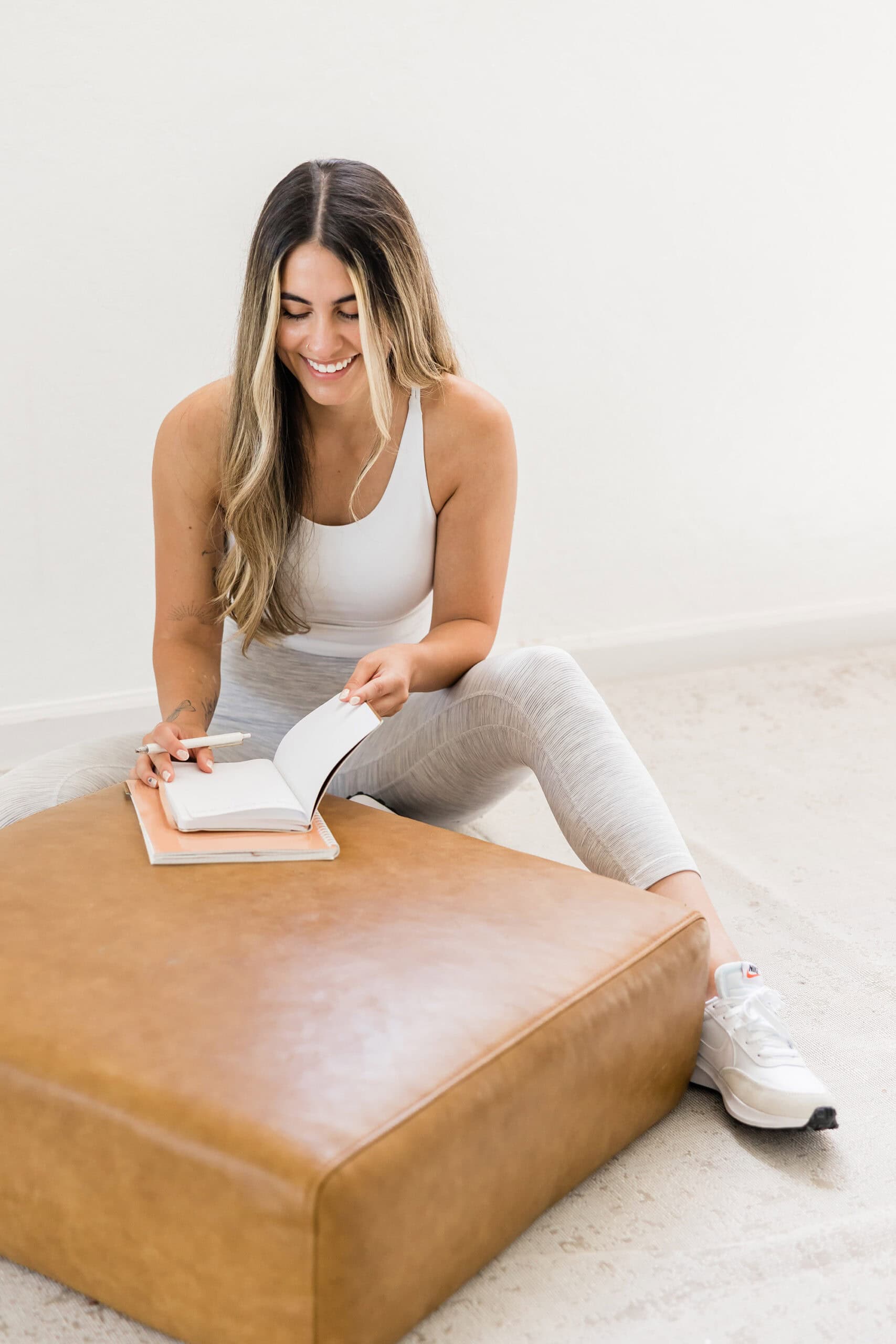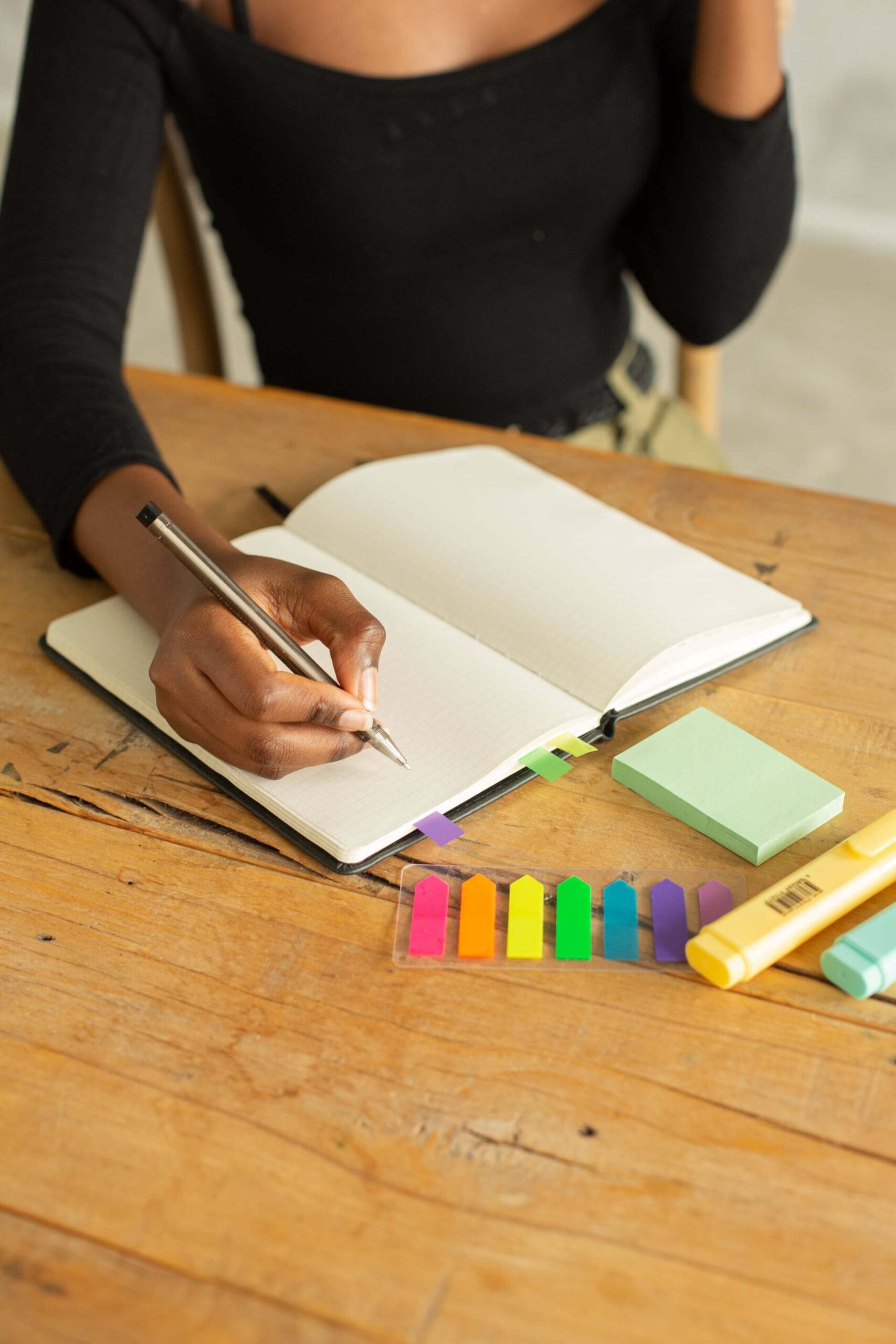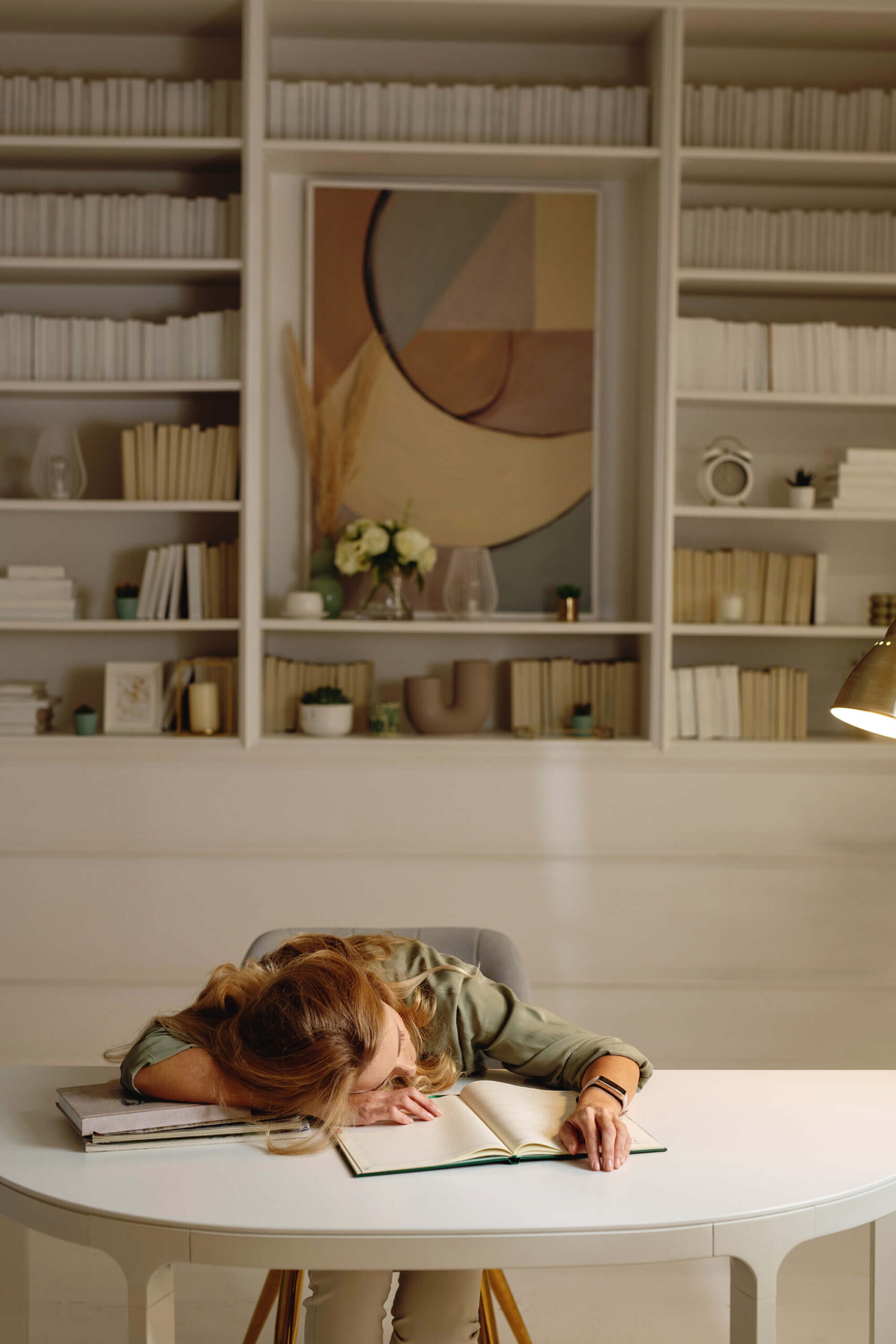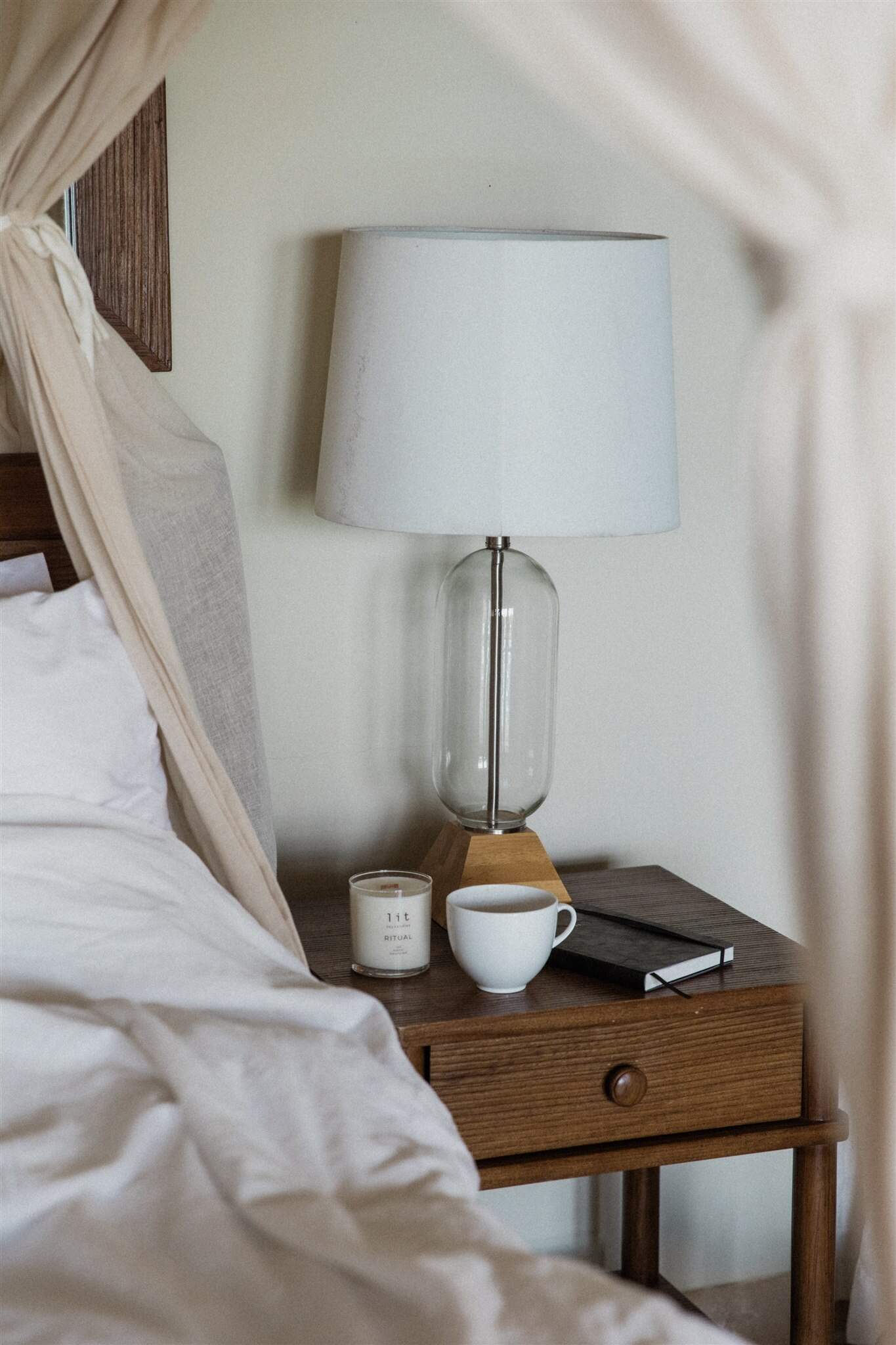As someone recently diagnosed with attention deficit hyperactivity disorder (ADHD), I *completely* understand the whirlwind of emotions and challenges that accompany it.
On any given evening, it wasn’t uncommon to find me restlessly *trying* to calm my ADHD brain.
I would sit on the couch and try to force myself to “rest” and “relax.” Because of my ever-racing mind, I would flit between looking at my phone, laptop, and the TV – all in search of a sweet-sweet dopamine hit that would somehow calm me down.
Instead, I’m *pretty* sure that I looked like a constipated puffer fish on speed.
Relaxing was not coming naturally to me. Until that is, I found calming activities for ADHD that *actually* worked.
If my story sounds like yours, just know that I empathize. The symptoms, ranging from difficulty concentrating to bouts of impulsiveness, are unique challenges that often feel overwhelming.
If you know, you know that having ADHD can make you feel as if your mind is constantly in overdrive, making it hard to focus or relax.
However, I’ve found that having a repertoire of calming activities for ADHD is absolutely essential to managing the symptoms of ADHD as a woman. Having go-to activities can serve as anchors in moments of chaos, grounding you and helping to soothe the storm in your mind.
They empower you to navigate daily challenges with greater ease and grace, transforming what once felt like insurmountable obstacles into manageable tasks.
If you’re ready to add ADHD relaxation techniques to your life and soothe your ADHD brain, you’ve come to the right place. Keep reading to learn about 20 of the top calming activities for women with ADHD.

1. Elevate Your Journal Game with Creativity
Journaling is a common yet supremely effective way to feel calmer daily.
Writing is an incredibly powerful tool for women with ADHD because it offers a nurturing space to organize thoughts, track emotions, and set personal goals.
It may seem like writing can’t do much, but taking the time to put pen to paper can enhance your problem-solving skills, reduce anxiety, and provide a calming routine to structure your day.
Through expressive journaling, you can explore their creativity (the next great novel, anyone?), which, in turn, fosters self-discovery and emotional well-being.
If writing in a journal is too dull, you can elevate your journal game with vibrant stickers, colorful pens, and decorative prompts, transforming what some may consider a mundane task into a fun activity.
Stickers can act as visual cues for important tasks and milestones, while colorful pens can differentiate between various thoughts and themes, making the journaling process more organized and visually appealing.
These tools make journaling more engaging, help you visualize ideas, and clear your thoughts.
By incorporating creative elements, journaling becomes an enjoyable practice that women with ADHD can use to make journaling more enticing and satisfying.
2. Discover Your Chill with Essential Oils
Have you ever wondered why some people swear by essential oils? Believe it or not, they can do more than smell nice.
Essential oils offer a soothing and aromatic way to relax and focus, making them an excellent addition to your self-care routine.
For women with ADHD, the calming effects of specific essential oils can help to reduce anxiety, improve concentration, and create a serene environment.
Lavender, chamomile, and frankincense are mainly known for their tranquil properties, while peppermint and eucalyptus can provide invigorating clarity when feeling mentally foggy.
If you are unsure how to use essential oils, a diffuser can help! It is a fantastic method for dispersing these beneficial scents throughout your space.
Diffusers come in various stylish designs, ensuring you can find one that matches your aesthetic while providing a steady release of calming aromas.
By experimenting with different scent combinations, you can tailor the atmosphere to your different needs—be it calming lavender for unwinding at night or refreshing peppermint for an afternoon pick-me-up.
Incorporating essential oils into your daily practices is an empowering way to nurture your well-being, making your environment a sanctuary of relaxation and focus.
3. Master Your Schedule with Intentional Planning
If your life tends to be a chaotic jumble of random things, you may need to realize how crucial (and calming) being organized can be.
Organization is a *powerful* tool, especially for women with ADHD, and planning on paper or utilizing digital apps can significantly contribute to a sense of structure in your life.
Paper planners provide tangible visual schedules for your daily, weekly, and monthly obligations, giving you a clear overview of commitments and priorities.
Additionally, physically writing down tasks can aid in memory retention and provide a satisfying sense of achievement as you check off completed items on your to-do lists.
If tech is more your thing, digital apps bring flexibility and convenience. They often have reminders, alerts, and custom features that can sync across multiple devices. These tools can help you break down larger goals into manageable steps, ensuring you stay on track without feeling overwhelmed.
Whether you prefer the tactile feel of a beautiful planner or the dynamic features of a digital app, mastering your schedule with these tools can instill a sense of control and calm, reducing the chaos often associated with ADHD.
This balance between organization and creativity empowers you to manage your day efficiently and take control of your executive functions. It allows you to reallocate your precious brainpower to things that matter.
4. Explore the Outdoors with Adventures in Nature
Are you outdoorsy? As someone who isn’t naturally nature-inclined, I understand how easy it is to discount its health benefits.
Believe it or not, spending time outdoors is incredibly beneficial for soothing the anxious feelings that can sometimes arise from ADHD.
Nature’s calming effect is well-documented. It offers a tranquil environment far removed from the sensory overload of daily life.
The natural world provides a gentle backdrop of sights and sounds (like gorgeous trees and chirping birds) that can ground you and reduce stress and anxiety.
Activities like walking, hiking, or sitting in a park can promote mindfulness. They allow you to focus on the present moment and give your mind a much-needed break from constant mental chatter.
As an added bonus, outdoor physical activity increases the production of endorphins, the body’s natural mood lifters, which can enhance emotional well-being.
By immersing yourself in the outdoors, you can find a peaceful reprieve that helps to manage ADHD symptoms and fosters a sense of inner calm.

5. Create Your Relaxation Playlist and Unwind With Tunes
If your mood has ever changed based on a song you just finished listening to, then you know that music can be a total game-changer for your outlook.
Music can completely alter your mood and bring calm and relaxation based on your choice.
The power of music lies in its ability to influence our emotional state and mental well-being.
Slow-tempo songs with soothing melodies and gentle rhythms can help lower stress levels and promote relaxed feelings by slowing heart rate and reducing cortisol, the body’s stress hormone.
Genres like classical, ambient, or acoustic are often associated with calming effects, making them an excellent choice for unwinding after a long day.
However, if pop, hip-hop, or any genre of music (no matter how unconventional) makes you feel calmer, feel free to add it to your playlist.
Curating playlists that align with your desired emotional state allows you to harness music’s therapeutic benefits, whether you need to relax, focus, or get motivated.
Adding music to your daily routine allows you to create an auditory oasis that helps manage ADHD symptoms and enhances your overall well-being.
6. Find Relaxation and Zen Mode with Easy Muscle Relaxation
If someone asked you to, could you tense and relax a random muscle – say your right thigh – at a moment’s notice?
If you can’t, don’t feel bad! Most people need to be pretty in tune with their bodies enough to have that much awareness and control. The good news is that it can be cultivated if you don’t have it now.
Enter progressive muscle relaxation (PMR), a technique that can be learned and practiced through videos or wellness apps. It involves tensing and relaxing different muscle groups, starting from your toes and ending up at your head.
The PMR process helps to increase awareness of physical sensations and can lead to a state of deep relaxation.
For women with ADHD, PMR can be particularly beneficial because it provides a structured method to reduce physical tension and mental stress.
This practice can help improve focus, lessen anxiety, and enhance overall emotional regulation. Incorporating PMR into your daily routine gives you a practical tool for managing symptoms and inducing a sense of calm and well-being.
7. Brew Your Bliss with Tea
When you think of a calm person, your brain may picture a person cradling a teacup or stirring liquid in a mug.
The ritual of brewing and enjoying tea can be a soothing practice for everyone, including people with ADHD.
Preparing tea—from boiling water to steeping leaves—encourages mindfulness and provides a break from the often chaotic pace of daily life, allowing for a moment of focused calm.
The tea itself contains compounds like L-theanine, which can promote relaxation without drowsiness and help mitigate symptoms of anxiety and stress.
This calming effect can make it easier to manage the racing thoughts and restlessness commonly associated with ADHD.
Moreover, establishing a tea-drinking ritual can offer structure and a much-needed pause in a busy day, contributing to greater emotional balance and increased concentration.
8. Manage Stress by Keeping Boundaries Real
Do you find yourself getting overrun with other people’s plans and desires?
Whether it’s personally, professionally, or in any other area of your life, a lack of boundaries can be a major contributor to anxious and stressful days.
Setting boundaries is crucial for happiness and calm, and this is especially true for women with ADHD.
Boundaries help you define what is acceptable and what isn’t, which helps to create a safe and predictable (i.e., calmer) life.
Clear boundaries can significantly reduce overstimulation and help you manage distractions, find focus (literally and figuratively), and reclaim your precious time.
Suppose you don’t know where to start when it comes to actually creating boundaries. In that case, you can start by setting limits on work hours, cherrypicking your social obligations (JOMO, anyone?), and limiting your screen time.
By establishing boundaries that you adhere to you can prevent burnout, improve your mental health, and allocate more time for self-care, relaxation, and things you *actually* want to do.
Additionally, as a bonus, solid boundaries can enhance relationships by ensuring clear communication and reducing misunderstandings and emotional stress.
Regardless of how and why you implement them, effective boundaries can be essential in creating a balanced life and helping you manage your symptoms and emotional well-being.

9. Do Some Chic Gardening with Plants
So many people are plant parents and tend to their greenery like they’re their pets (or kids). Subconsciously or not, many people understand the benefits of gardening.
Gardening is extremely well-known as a relaxing activity. It can provide a serene and structured environment where one can focus on the tactile experience of nurturing plants.
Planting, watering, and tending a garden offers a hands-on, mindful approach to managing symptoms and embracing stillness.
When you immerse yourself in gardening, your mind shifts from the stressors of everyday life to the calming rhythm of nature.
Caring for a living thing like a plant reduces stress and anxiety and instills a sense of accomplishment and pride as you witness it flourish.
The gentle repetition of gardening tasks can help create a reassuring sense of order and predictability.
Whether cultivating a fresh herb garden (your home-cooked meals will thank you) or growing trendy succulents, gardening can empower you with quiet confidence and provide a peaceful escape from the chaos of your busy daily life.
10. Master Quick and Delicious Snack Recipes
Are you a snacker? If you’re like me, you can plop on the sofa with a bowl of popcorn and scarf it down before Netflix asks, “Are you still watching?”
Snacking can be a calming and comforting activity. And, when done mindfully, snacking serves as a way to ground oneself and bring a moment of pause (and joy) into a hectic day.
However, you can make your tendency to snack a healthier activity by opting for nutritious snacks.
Not only do healthy snacks satisfy hunger, but they also provide essential nutritional benefits that support cognitive function and emotional well-being.
For women with ADHD, balancing energy levels throughout the day is crucial, and healthy snacks like nuts, fruits, yogurt, and whole-grain crackers can help achieve this balance.
By choosing snacks rich in protein and healthy fats, you can maintain more stable blood sugar levels, which is linked to improved focus and mood.
Choosing or preparing nutritious snacks can be an empowering and delicious strategy to nourish your body, fuel your mind, and introduce a sense of calm into your busy life.
RELATED: 24 Genius Ways to Beat the ADHD Afternoon Crash for Women
11. Get Lost in Adult Coloring for Chill Moments
Coloring isn’t just child’s play anymore—it’s a glorious escape for adults, too!
Engaging in adult coloring books offers a perfect blend of nostalgia and creativity, which makes it one of the most enjoyable creative activities for anyone looking to unwind.
Adult coloring books come in various styles, ranging from intricate mandalas and abstract designs to nature scenes and even NSFW themes. This diverse selection lets you choose artwork that resonates with your interests and artistic flair.
One reason adult coloring is so popular is its ability to invoke a sense of calm and mindfulness.
As you focus on coloring within the lines and selecting shades, your mind shifts away from daily stressors and concerns, fostering relaxation and mental clarity.
Also, coloring is perfect if recapturing a nugget of your elementary school days excites you. It’s a chance to relive those carefree moments while simultaneously participating in a creative and therapeutic process.
So pull out your colored pencils, crayons, or markers and dive into your next masterpiece—your inner child will thank you!
12. Find Pet Love with Furry Friends
Everyone knows that pets can serve as incredible sources of comfort and support, especially for people who may experience heightened anxiety.
The unabashed love and companionship pets provide can create a nurturing environment that feels both safe and reassuring.
Interacting with pets through playing, walking, or cuddling releases oxytocin, the “love hormone,” which naturally reduces stress and anxiety.
The rhythmic and repetitive actions involved in pet care, like brushing your pet or dropping feed into their bowl, can bring a soothing routine to your day.
Furthermore, having a pet can encourage physical activity and outdoor time, which improves mood and reduces anxiety.
By establishing a bond with their furry friends, you can help your ADHD mind to experience a delightful break from their worries, reconnecting with the present moment in a cuddly and gratifying way.

13. Enhance Your Sleep with the Right Gear
If you’re human, you know that waking up after a *rough* night of sleep is no fun.
Sleep is not just a necessity; it’s a luxurious escape that can transform your entire well-being. Good quality sleep is a calming activity because it allows your body and mind to recover and rejuvenate, easing away the stresses of the day.
If you’re not getting enough sleep or high-quality rest, you’re missing out. Luckily, there are effective methods to improve your sleep situation and get the high-quality shuteye you deserve.
Items like plush weighted blankets, soothing essential oil diffusers, and high-tech sleep trackers can turn your bedtime into a nightly treat you can’t wait to indulge in.
Imagine sinking into a bed adorned with soft, breathable linens that cradle you in comfort, gently guiding you into a restful slumber. If the thought of that made your eyelids heavy and your pulse slower, it may be time to do some shopping.
Integrating fun and stylish sleep accessories into your routine can make the journey to dreamland something you eagerly anticipate each night and help to ensure you wake up refreshed, empowered, and ready to conquer the day ahead.
14. Chill Out with Visualization
Do you ever stop and daydream, or better yet, visualize? If not, you’re missing out on a majorly effective way to feel calmer quickly.
Visualization, whether practiced solo or with guidance, can be a powerful method for achieving a state of calm and peace.
By immersing yourself in a serene mental place—your fantasy life or a fictional place altogether—you effectively transport your mind away from the stresses and worries of everyday life.
When practiced regularly, solo visualization can help you harness the power of your imagination to create tailored scenes that resonate with your personal happy place.
On the other hand, guided visualization apps provide structured experiences, using relaxing narratives and soothing imagery to ease you into a meditative state.
Both methods encourage deep breathing and present-moment awareness, enhancing your ability to focus and relax.
Through visualization, you can nurture a sense of inner calm, reduce anxiety, build emotional resilience, and even incorporate manifestation to calmly face life’s daily challenges.
15. Instantly Calm Your Mind Using Your Breath
I’m a big fan of breathing. It sounds silly, but deep breathing exercises can be a straightforward yet effective way to get stress and anxiety under control.
These exercises engage the parasympathetic nervous system, promoting rest and tranquility.
Methods like deep belly breathing, box breathing, or the 4-7-8 method can be practiced anytime and anywhere, making them ideal for managing stress on the go.
By focusing on intentional, rhythmic breaths, you encourage your mind *and* body to slow down and create quiet space that helps reduce feelings of anxiety and tension.
These breathing exercises remind you that peace and calm are just a breath away, empowering you to take control of your well-being with ease and grace.
With regular practice, breathing exercises can become a cornerstone of your self-care routine, enhancing your overall sense of relaxation and anxiety regulation.
16. Center Your Thoughts with Quick Mindfulness Sessions
Mindfulness is a word that gets thrown around constantly, but what does it mean in real life?
Believe it or not, mindfulness isn’t as complicated as it may seem and, in practice, is simply the act of being aware of your thoughts or what you’re doing at this exact moment.
For example, household chores like washing dishes or folding laundry are standard mindfulness practices.
Engaging in quick and simple mindfulness exercises throughout the day can significantly enhance your sense of calm and tranquility.
These brief practices offer a powerful way to reconnect with the present moment, grounding you amidst the hustle and bustle of daily life.
Whether you take a few deep breaths, do a short mindfulness meditation, or notice your surroundings, these moments can act as a reset button, melting away stress and anxiety.
As you incorporate these exercises into your routine, you’ll become more aware of your inner state, fostering emotional resilience and a chill mindset.

17. Connect with Your Crew
No matter what you’re trying to accomplish or what life stage you’re in, having access to like-minded individuals can make an incredible difference in your mindset.
Connecting with friends who share your outlook or engaging in wellness groups can significantly enhance your calm and well-being.
When you surround yourself with people who share your passions and interests, you create a supportive squad where you can exchange ideas, experiences, and encouragement.
If it suits you, consider scheduling regular visits or phone calls with friends. Make a point to meet new people or join groups that interest you.
These interactions foster a sense of belonging and provide a vital network that can offer comfort and motivation during challenging times.
Together, you can celebrate achievements, navigate obstacles, and create a nurturing environment that promotes emotional and mental balance.
18. Maximize Your Living Space to Suit Your Style
Having a home that fits your visual and practical needs can be an underestimated source of calm.
Your home should be a sanctuary where you feel safe, comfortable, and inspired. You create an environment that nurtures your spirit by thoughtfully incorporating colors, textures, and elements that resonate with you.
For example, soft hues like white and light neutrals may promote tranquility, while vibrant accents like yellow and orange can bring energy and joy. Including elements from nature, such as plants or natural materials, helps to create a grounding atmosphere.
Additionally, decluttering your space reduces distractions and promotes mental health clarity, making it so much simpler to relax and focus.
When your surroundings are aligned with your inner self, you create a supportive backdrop for rest, creativity, and relaxation.
Tailoring your home to suit your preferences is a powerful way to foster a serene and empowering living space.
19. Stay Fit with Regular Movement
It’s cliche, but physical exercise can significantly benefit and calm your nerves.
More specifically, calming physical activities that promote physical health and enhance focus and emotional well-being are some of the best ways to wrangle your ADHD brain.
Yoga, for instance, is a good option. It combines gentle movements with deep breathing techniques, which can help alleviate stress and enhance your concentration.
Another excellent way to get regular physical activity is Pilates, which focuses on controlled movements and core strength. It promotes mindfulness and a strong mind-body connection.
With its slow and deliberate motions, Tai Chi can be highly beneficial since it encourages mental clarity and relaxation.
Additionally, walking or gentle running in nature provides a soothing way to stay active and expend excess energy while enjoying the calming effects of the outdoors.
Getting this type of regular exercise is about more than physical fitness. These movement breaks offer holistic benefits that nurture the body and mind, creating a balanced routine and supporting overall well-being.
20. Challenge Yourself to a Tech-Free Digital Detox
In today’s hyper-connected world, taking a break from technology, even briefly, can seem completely unrealistic. However, if you can manage to take a well-deserved break, it can be incredibly calming and rejuvenating.
When you disconnect from digital devices, you allow yourself to be fully present in the moment, reducing the constant mental chatter and distractions that come with notifications and screen time.
This quiet time allows your mind to rest and recharge, creating peace and clarity. You may feel more in tune with your emotions and surroundings, allowing more profound relaxation and creativity.
Remember, taking a tech break doesn’t have to be daunting.
Start small by setting aside specific times during the day to go device-free, or designate particular areas in your home as tech-free zones. Small, bite-size steps can make a significant difference in cultivating a calm and balanced lifestyle.
The Takeaway
Anxiety, stress, worry, and impulsiveness are just a few of the common ADHD symptoms that you may be encountering.
While these feelings can seem like *a lot* to deal with, there are different ways to realistically and practically feel calmer, more in control, and relaxed.
From engaging in mindful practices such as visualization and nature walks to establishing tech-free zones for mental clarity, each strategy is tailor-made to enhance balance and well-being.
Incorporating these effective calming techniques into your daily routine can create a healthier, less stressful, and more fulfilling life. These strategies can help you embrace your strengths and challenges with grace and resilience.
If you are experiencing persistent symptoms that aren’t improving, don’t be afraid to seek professional support from a doctor or medical professional.
Remember, even tiny changes can lead to significant improvements. All you need to start feeling calmer in your everyday life is to make the first change.

Don’t let your ADHD brain get the best of you.
Real-Life
Work in Progress.
Founder. Writer.
Roxy is the creator of The Everyday Flourish, a relatable personal growth blog for women who are tired of burnout, chaos, and hustle culture.
A recovering overthinker and unofficial life guinea pig, she shares honest self-care strategies, ADHD-friendly productivity tips, and mindset shifts that actually feel doable.
Around here, personal growth comes with grace, not pressure - and a lot fewer to-do lists.








